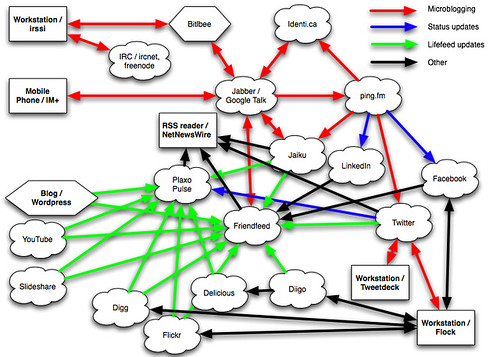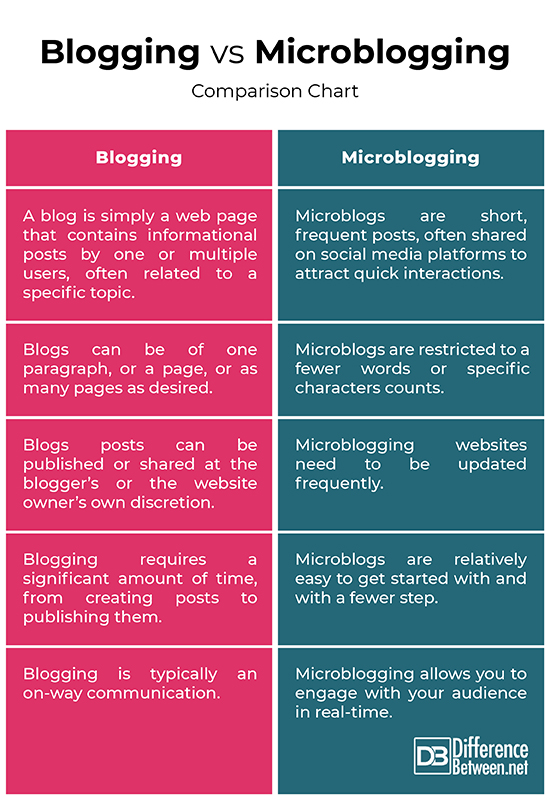Difference Between Blogging and Microblogging
Thinking of how best to promote your business online and make a strong online presence? Blogs are the easiest way to make your voice heard and put your message out there. Then, there is microblogs, which are a short and easy way to connect with your audience online. Blogging is definitely at the top of the content marketing game, but microblogging is very effective when it comes to spreading real-time info quickly and easily. So, what are the differences between blogging and microblogging?

What is Blogging?
The term “blog” came from “web log” – an online journal for displaying information. Over time, like most new innovations on the Internet, web logs have become “blogs”. Blogs are part of the current changes in journalism and marketing. Blogs are also part of the growth of social media networks like Facebook and Twitter. Blogging is the easiest way to get your message out there and make your voice heard. It is the new platform for instant publishing, and it’s updated frequently. Blogs are streamlined web pages that funnel your thoughts and make it to the World Wide Web as soon as you finished typing. Blogs are an easy way to keep the readers up to date on what’s going around and they are easily accessible via links available on the blogger’s own or business website, his/her social media profiles, or newsletters. Blogs are also searchable by keyword or browseable by date. A blog is simply a web page that contains informational posts by one or multiple users, often related to a specific topic.

What is Microblogging?
Microblogging is a form of blogging combined with instant messaging wherein the messages are restricted to specific character counts. Microblogging refers to short messages or posts shared with an audience online through Microblogging platforms, such as Twitter, Instagram, and Tumblr. Unlike traditional blogs, microblogs are brief and straight to the point. Microblogging is posting on sites and platforms such as Twitter, which allows you to write posts, share pictures, upload clips and videos, and send GIFs to another account. Twitter is the best know microblogging platform, but many others still exist. Some organizations and businesses have private microblogging systems for internal use only, which are sometimes referred to as enterprise microblogging. Although, many of the concepts of regular blogging apply to microblogging as well, the length restrictions call for a different approach to composition of posts. Microblogs refer to short, frequent posts, often shared on social media platforms, which attract quick interactions with an online audience.
Difference between Blogging and Microblogging
Meaning
– Blogging is the practice of writing and controlling a blog – an informational web page (or website) consisting of discrete, informal-style entries published on the World Wide Web or links to other websites, and which can be used for personal use or for marketing purposes. A blog is simply a web page that contains informational posts by one or multiple users, often related to a specific topic.
Microblogging, on the other hand, refers to short messages or posts shared with an audience online through Microblogging platforms, such as Twitter, Instagram, and Tumblr.
Content
– Blogs are much more than simple web publishing; they are information-rich, customer-centric articles based on a specific subject that combine text, imaged and links to other web pages or blogs related to similar topic. Blogs can also be instructional resources for providing education related content, plus they provide commentary on certain topic, ranging from politics to entertainment and sports.
Microblogs, on the other hand, are short, frequent posts, often shared on social media platforms, which attract quick interactions with an online audience. Twitter is the best know microblogging platform, but many others still exist.
Limit
– Blogs are the easiest way to share your ideas and opinions and publish your thoughts without sticking to any character limits. Blogs can be of one paragraph, or a page, or as many pages as desired, coupled with digital images, graphics, infographics, and multimedia content.
Microblogs, on the contrary, are small, concise, subject-specific posts that involve a fewer word. The microblogging content is brief and straight to the point with short sentences, individual images or video links, which are restricted to a fewer words or specific characters counts.
Real-Time Communication
– Although, blogging takes a significant amount of time, from setting things up to get started to adding images and videos to content, to finally publishing the content. Blogs are the easiest way to get your message out there and make your voice heard and connect with your audience. Blogging is typically an on-way communication – you write, publish and share your thoughts.
Microblogging, unlike blogging, is specially designed for quick interactions with online audience and it is the fastest way to reach your audience compared to regular blogging, plus microblogging also allows you to engage with your audience in real-time.
Blogging vs. Microblogging: Comparison Chart

Summary
In a nutshell, blogging requires a lot of research and fact -gathering to create the final piece that users might find appealing. The real challenge is the amount of time you need, from setting things up to get started to adding images and videos to content, to finally publishing the content. Blogging is a long-time commitment and it may prove to be a costly affair for those who are new to blogging. Microblogging, however, is a faster way to put your message out there and engage with as many audiences as possible in real-time. Unlike regular blogging, microblogs are designed to attract quick audience interactions and they are easily accessible of mobile.
- Difference Between FTP and SFTP - April 16, 2024
- Difference Between El Nino and La Nina - April 13, 2024
- Difference Between an Arbitrator and a Mediator - April 11, 2024
Search DifferenceBetween.net :
 Email This Post
: If you like this article or our site. Please spread the word. Share it with your friends/family.
Email This Post
: If you like this article or our site. Please spread the word. Share it with your friends/family.
2 Comments
Leave a Response
References :
[0]Rettberg, Jill Walker. Blogging, Second Edition. Cambridge, United Kingdom: Polity Press, 2014. Print
[1]Stone, Biz. Blogging: Genius Strategies for Instant Web Content. Indianapolis, Indiana: New Riders, 2002. Print
[2]Bovee, Courtland L., et al. Business Communication Today, Thirteenth Edition. Noida, India: Pearson India, 2016. Print
[3]Image credit: https://live.staticflickr.com/4319/36178676551_3ca0588c34_b.jpg
[4]Image credit: https://live.staticflickr.com/3429/3308183411_5b7fda19d7.jpg


Hey sagar, this is a good article. Anybody who wants to start blogging should absolutely read this first and determine what they want and what they don’t from the beginning. Thanks for sharing this. Cheers!
Micro blogging